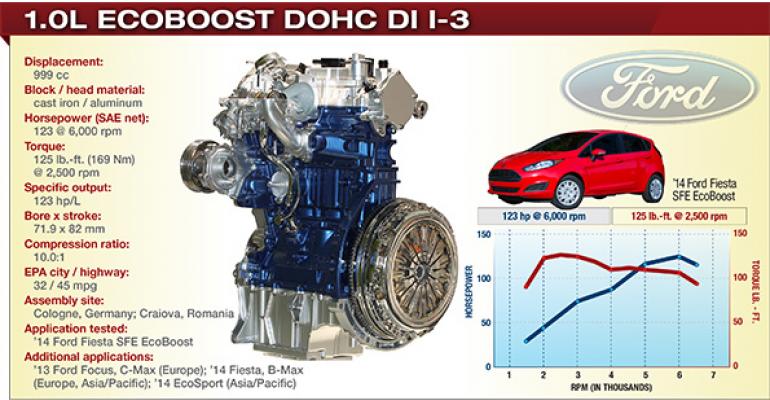It wasn’t long ago that U.S. car buyers thought more always was better when it came to cylinders. Ford’s new 1.0L EcoBoost proves good things really do come in small packages. It’s not the first 3-cyl. engine to be offered in the U.S., but it is the first one that truly is fun to drive.
So-called triples long have been admired in the motorcycle world for their compact dimensions and distinctive tailpipe howl, but their reputation in U.S. cars is not good.
In the 1980s and 1990s, they were synonymous with thrashy, underpowered econoboxes.
We’ve pointed out many times that given the strict cost constraints, developing a great engine for entry-level vehicles can be more challenging than creating one for a new luxury car. What engineers and designers accomplished with this little gem needs to be recognized.
First, they created an attractive value proposition by offering a highway fuel-economy rating of 45 mpg (5.2 L/100 km) on the Ford Fiesta. Then they made it as powerful as conventional engines 50% bigger. Thanks to gasoline direct injection combined with turbocharging, it makes 123 hp and 148 lb.-ft. (200 Nm) of torque per liter. That is gold-standard specific output for any engine, let alone an entry-level powerplant.
 Ford also found an elegant solution to a problem that plagues all inherently unbalanced 3-cyl. engines: a pitch and yaw motion that creates vibration and a booming noise. Usually balance shaft technology is used to counteract this rocking motion, but it adds significant cost, weight and friction; plus it hurts fuel efficiency.
Ford also found an elegant solution to a problem that plagues all inherently unbalanced 3-cyl. engines: a pitch and yaw motion that creates vibration and a booming noise. Usually balance shaft technology is used to counteract this rocking motion, but it adds significant cost, weight and friction; plus it hurts fuel efficiency.
Instead of a balance shaft, engineers intentionally “unbalanced” the flywheel and crank pulley in conjunction with optimizing the engine mounts to offset the engine shaking forces.
Then engineers hit the ball out of the park when they made this 3-cyl. desirable rather than just acceptable. It has high peak torque at low rpm, but it also likes to rev freely and has a robust exhaust note, making it fun to run through the gears. You don’t expect this kind of driving pleasure from a car with a base price slightly more than $16,000.
“I would be happy with this engine,” says one WardsAuto editor. “One of the best-sounding entry-level engines I’ve ever heard,” comments another.
In addition, this mighty little engine is loaded with advanced technology, including variable cam timing on both intake and exhaust valves and high fuel injection pressures up to 2,176 psi (150 bar). Combined with 6-hole solenoid injectors, the fuel-management system allows multiple injections per combustion event to optimize efficiency.
It all adds up to a lot of engineering and performance in a very compact package and it is a perfect way to reintroduce a new generation of 3-cyl. car engines to a skeptical American audience.
We are giving the 1.0L Ford EcoBoost an award, but we know several automakers gearing up 3 cyls. for the U.S. that should at least send Ford a thank you note.



